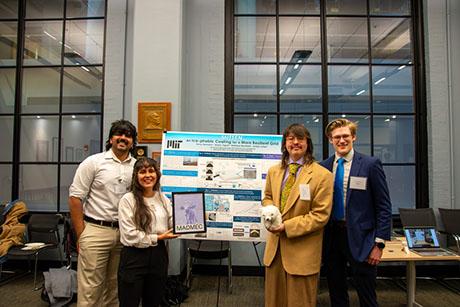MIT Electric Vehicle Team: An Electrifying Start
 |
 |
| Professional motorcycle rider Allan Brew, seated, with, from left, MITEVT team members Mark Jeunnette, Lennon Rodgers, Radu Gogoana, Randall Briggs, and Erick Fuentes. |
It was the first qualifying race of the event and MIT’s electric motorcycle had never been raced on the road before. Each Electric Vehicle Team (EVT) member stood transfixed by an empty finish line, waiting anxiously for their bike to fly by. It was the moment they had all been waiting for, nearly two years in the making. After all their plans, strategies, late nights, and tests, team members Lennon Rodgers, Radu Gogoana, Mark Jeunnette, Randall Briggs, and Erick Fuentes wondered how their bike would perform in the real deal.
“The first qualifier is a big event,” says MIT EVT Leader and mechanical engineering PhD student Lennon Rodgers. “The rider speeds off, circles the entire island, and you hope he appears again in less than 30 minutes. It was a great feeling when they announced that our rider was going 96 mph through the first speed trap, because before that we really had no idea how our bike would perform on the actual course. He finished in about 28 minutes, and I think we’ll all remember that first race as one of the coolest, just because we were all so excited to see him come over the final hill and speed across the finish line.”
An Idea is Born
The race in question was the famous Tourist Trophy (TT) race on the Isle of Man – a self-governing island located in the Irish Sea – that first started more than 100 years ago in 1907. Its legendary mountainous and curvy track has been the site of many motorcycle races throughout the years, and recently, in 2009, a new race for electric motorcycles was added to the lineup.
It was watching this new race on the Internet while working in an MIT machine shop that prompted Rodgers and the rest of the EVT to build a bike to race in the electric-only TT Zero race. Fast-forward two years later, in June of 2011, and they did exactly that, coming in as the third-place team with the fourth-place bike (one of the teams raced two bikes). Meanwhile, though, there was a lot of planning, developing, and strategizing necessary to build an electric bike that could make it to the starting line, never mind the finish line.
A Well Laid Plan
A main element of the team’s strategy – beyond coming prepared with spare parts for just about everything and conducting a multitude of tests before, during, and after – was to figure out a way to give their rider the ability to go full throttle for the entirety of the race.
“That way our rider could focus on driving and not worry about the speed he was going,” explains Rodgers. “A lot of the other bikes’ motors were actually a lot more powerful than what their batteries could sustain, so if their riders didn’t control the speed, they would run out of battery life before the end of the race.”
Their strategy was possible because of mathematical models they developed to predict the energy consumption of the motorcycle along the entire 37-mile course. Extensive dynamometer readings and track tests gave them the confidence they needed that their calculations were correct. The motorcycle was fully instrumented and in the end used 95% of its battery energy during the race.
Never a Dull Moment
Despite being well prepared with a reliable, tested bike, the EVT still ran into some dramatic moments that made them doubt their ability to race at all. The most dramatic of times was after the first qualifier when Rodgers took the bike out to the countryside for some additional practice runs.
“Right before the second qualifier, we realized that there was something rubbing in the motors, but we didn’t know why,” says Rodgers. “It’s a difficult situation in terms of risk management when you don’t know why something is happening, since you don’t know if it will happen again or get worse. What we did know is that rubbing creates heat, and heat makes things expands, and it’s a runaway effect. It definitely wasn’t something we could ignore.”
As the time remaining before the next race ticked quickly by and tension steadily built, the team debated whether or not to rebuild the motors, not even knowing for sure if that would fix their problem. They were worried about how long it would take because they had to remove more than 10 parts just to access the motor, nevermind the time it would take to actually fix it. But in the heat of discussion, Gogoana, who was responsible for the motor, devised a clever “Apollo 13” plan that would avoid taking out all the parts. But it was risky.
“We worked into the night but got the bike back together and to the race just in time,” says Rodgers. “We won fourth place in the second qualifier.”
The Results are In
Not only was EVT the fastest first-year team, they were also the fastest student-run team. “The greatest strength for us was reliability,” says Rodgers. “One of our main strategies was to build a very reliable bike, and we were one of the few teams that didn’t have reliability issues during the race.
“We were all very pleased with the way things turned out,” he says. “Of the two teams that finished ahead of us, one of them was a group of professional engineers, and the other was a university team led by a professor. But for us, a team of all students, we did everything beginning to end all on our own.”![]()
The EVT would like to acknowledge their sponsors – A123 Systems, BMW, MIT-Singapore International Design Center, Singapore University of Technology and Design, MIT Energy Initiative, MIT Transportation, MIT Department of Mechanical Engineering, and MIT School of Engineering – as well as their professional rider Allan Brew.

